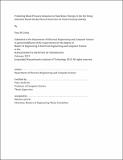Predicting blood pressure response to fluid bolus therapy in the ICU using attention-based stacked neural networks for clinical interpretability
Author(s)
Girkar, Uma M.
Download1102056752-MIT.pdf (392.4Kb)
Other Contributors
Massachusetts Institute of Technology. Department of Electrical Engineering and Computer Science.
Advisor
Peter Szolovits.
Terms of use
Metadata
Show full item recordAbstract
Fluid bolus therapy (FBT) is a treatment commonly administered to treat seriously ill hypotensive patients in intensive care units (ICUs). Unfortunately, only a fraction of hypotensive patients respond positively to FBT, and emergency room physicians are constantly challenged in determining whether administering FBT will result in a corresponding increase in blood pressure. In this thesis, we utilized regression models and attention-based recurrent neural network (RNN) algorithms to predict the response of hypotensive patients to FBT from a multi-clinical information system large-scale database. We investigated time-series modeling with the use of the stacked long short term memory network (LSTM) and the gated recurrent units network (GRU) models by altering the representation of our data and time-aggregated modeling using logistic regression algorithms with regularization on our original representation. Additionally, we applied the attention mechanism for clinical interpretability on our RNN models applied on the time-series representation. Among all the modeling strategies and data representations, the stacked LSTM with the attention mechanism predicted the success or failure of the FBT on hypotensive patients with a highest accuracy of 0.852 and area under the curve (AUC) value of 0.925. The aim of the study is to help identify hypotensive patients in ICUs who will experience a sufficient increase in blood pressure after FBT administration. The end goal of these results would be to develop a clinically actionable decision support tool for intensive care management.
Description
This electronic version was submitted by the student author. The certified thesis is available in the Institute Archives and Special Collections. Thesis: M. Eng., Massachusetts Institute of Technology, Department of Electrical Engineering and Computer Science, 2019 Cataloged from student-submitted PDF version of thesis. Includes bibliographical references (pages [38]-[40]).
Date issued
2019Department
Massachusetts Institute of Technology. Department of Electrical Engineering and Computer SciencePublisher
Massachusetts Institute of Technology
Keywords
Electrical Engineering and Computer Science.